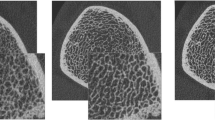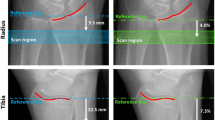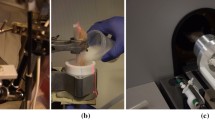Abstract
Summary
In vivo high-resolution peripheral quantitative micro-CT (HR-pQCT) is a new modality for imaging peripheral sites like the distal tibia and the distal radius, providing structural bone parameters. Comparing HR-pQCT with MRI, we found that both modalities are capable of offering meaningful information on trabecular structure.
Background
Magnetic resonance imaging (MRI) has emerged as the leading in vivo method for measuring trabecular bone micro-architecture and providing structural information. Recently, an in vivo HR-pQCT modality was introduced for imaging peripheral sites like the distal tibia and the distal radius, providing structural bone parameters. The goal of this work was to compare and evaluate the performances and in vivo capabilities of HR-pQCT in comparison with MRI at 3 Tesla.
Methods
To this end images of 8 human specimens (5 tibiae and 3 radii) and 11 participants (6 tibia and 5 radii) were acquired with both modalities. Additionally, the radius specimens were scanned with micro-CT (μCT), which was used as a standard of reference. Structural parameters calculated from MRI were compared with results from HR-pQCT images and additionally μCT for the radii specimens.
Results
High correlations (r > 0.7) were found for trabecular number and trabecular spacing between the two modalities in vivo and ex vivo. 2D and 3D analysis revealed high correlations (r > 0.8) in structural bone parameters for all measurements. Using micro-CT as standard of reference both results from QCT and MRI correlated well.
Conclusion
Both imaging modalities were found to perform equally well regarding trabecular bone measurements.





Similar content being viewed by others
References
Kanis JA, Melton LJ III, Christiansen C, Johnston CC, Khaltaev N (1994) The diagnosis of osteoporosis. J Bone Miner Res 9:1137–1141
Link TM, Vieth V, Matheis J, Newitt D, Lu Y, Rummeny EJ, Majumdar S (2002) Bone structure of the distal radius and the calcaneus vs BMD of the spine and proximal femur in the prediction of osteoporotic spine fractures. Eur Radiol 12:401–408
Link TM, Majumdar S, Grampp S, Guglielmi G, van Kuijk C, Imhof H, Glueer C, Adams JE (1999) Imaging of trabecular bone structure in osteoporosis. Eur Radiol 9:1781–1788
Kinney JH, Ryaby JT, Haupt DL, Lane NE (1998) Three-dimensional in vivo morphometry of trabecular bone in the OVX rat model of osteoporosis. Technol Health Care 6:339–350
Stenstrom M, Olander B, Lehto-Axtelius D, Madsen JE, Nordsletten L, Carlsson GA (2000) Bone mineral density and bone structure parameters as predictors of bone strength: an analysis using computerized microtomography and gastrectomy-induced osteopenia in the rat. J Biomech 33:289–297
Cooper C (1993) The epidemiology of fragility fractures: is there a role for bone quality? Calcif Tissue Int 53 [Suppl 1]:S23–S26
Dempster DW, Ferguson-Pell MW, Mellish RW et al (1993) Relationships between bone structure in the iliac crest and bone structure and strength in the lumbar spine. Osteoporos Int 3:90–96
Kleerekoper M, Villanueva AR, Stanciu J, Rao DS, Parfitt AM (1985) The role of three-dimensional trabecular microstructure in the pathogenesis of vertebral compression fractures. Calcif Tissue Int 37:594–597
Uitewaal PJ, Lips P, Netelenbos JC (1987) An analysis of bone structure in patients with hip fracture. Bone Miner 3:63–73
Majumdar S (2002) Magnetic resonance imaging of trabecular bone structure. Top Magn Reson Imaging 13:323–334
Wehrli FW, Saha PK, Gomberg BR et al (2002) Role of magnetic resonance for assessing structure and function of trabecular bone. Top Magn Reson Imaging 13:335–355
Boutroy S, Bouxsein ML, Munoz F, Delmas PD (2005) In vivo assessment of trabecular bone microarchitecture by high-resolution peripheral quantitative computed tomography. J Clin Endocrinol Metab 90:6508–6515
Hipp JA, Jansujwicz A, Simmons CA, Snyder BD (1996) Trabecular bone morphology from micro-magnetic resonance imaging. J Bone Miner Res 11:286–297
Jara H, Wehrli FW, Chung H, Ford JC (1993) High-resolution variable flip angle 3D MR imaging of trabecular microstructure in vivo. Magn Reson Med 29:528–539
Krug R, Han ET, Banerjee S, Majumdar S (2006) Fully balanced steady-state 3D-spin-echo (bSSSE) imaging at 3 Tesla. Magn Reson Med 56:1033–1040
Techawiboonwong A, Song H, Wehrli FW, Saha PK (2004) Relative performance of FLASE, TrueFISP and gradient echo in micro-MRI of trabecular bone. International Society for Magnetic Resonance in Medicine, Kyoto
Laib A, Beuf O, Issever A, Newitt DC, Majumdar S (2001) Direct measures of trabecular bone architecture from MR images. Adv Exp Med Biol 496:37–46
Hildebrand T, Ruegsegger P (1997) A new method for the model-independent assessment of thickness in three-dimensional images. J Microsc 185:67–75
Banerjee S, Choudhury S, Han ET, Brau AC, Morze CV, Vigneron DB, Majumdar S (2006) Autocalibrating parallel imaging of in vivo trabecular bone microarchitecture at 3 Tesla. Magn Reson Med 56:1075–1084
Griswold MA, Jakob PM, Heidemann RM, Nittka M, Jellus V, Wang J, Kiefer B, Haase A (2002) Generalized autocalibrating partially parallel acquisitions (GRAPPA). Magn Reson Med 47:1202–1210
Majumdar S, Genant HK, Grampp S, Newitt DC, Truong VH, Lin JC, Mathur A (1997) Correlation of trabecular bone structure with age, bone mineral density, and osteoporotic status: in vivo studies in the distal radius using high resolution magnetic resonance imaging. J Bone Miner Res 12:111–118
Newitt DC, van Rietbergen B, Majumdar S (2002) Processing and analysis of in vivo high-resolution MR images of trabecular bone for longitudinal studies: reproducibility of structural measures and micro-finite element analysis derived mechanical properties. Osteoporos Int 13:278–287
Majumdar S, Genant HK (1997) Assessment of trabecular structure using high resolution magnetic resonance imaging. Stud Health Technol Inform 40:81–96
Laib A, Newitt DC, Lu Y, Majumdar S (2002) New model-independent measures of trabecular bone structure applied to in vivo high-resolution MR images. Osteoporos Int 13:130–136
Laib A, Ruegsegger P (1999) Comparison of structure extraction methods for in vivo trabecular bone measurements. Comput Med Imaging Graph 23:69–74
Link TM, Majumdar S, Augat P et al (1998) In vivo high resolution MRI of the calcaneus: differences in trabecular structure in osteoporosis patients. J Bone Miner Res 13:1175–1182
Majumdar S, Kothari M, Augat P et al (1998) High-resolution magnetic resonance imaging: three-dimensional trabecular bone architecture and biomechanical properties. Bone 22:445–454
Majumdar S, Link TM, Augat P, Lin JC, Newitt D, Lane NE, Genant HK (1999) Trabecular bone architecture in the distal radius using magnetic resonance imaging in subjects with fractures of the proximal femur. Magnetic Resonance Science Center and Osteoporosis and Arthritis Research Group. Osteoporos Int 10:231–239
Banerjee S, Han ET, Krug R, Newitt DC, Majumdar S (2005) Application of refocused steady-state free-precession methods at 1.5 and 3 T to in vivo high-resolution MRI of trabecular bone: simulations and experiments. J Magn Reson Imaging 21:818–825
Krug R, Carballido-Gamio J, Burghardt AJ, Haase S, Sedat JW, Moss WC, Majumdar S (2007) Wavelet-based characterization of vertebral trabecular bone structure from magnetic resonance images at 3 T compared with micro-computed tomographic measurements. Magn Reson Imaging 25:392–398
Acknowledgement
This work is funded by UCSF Radiology Seed Grant #05-16 and by NIH grant award program number R01-AR49701.
Author information
Authors and Affiliations
Corresponding author
Rights and permissions
About this article
Cite this article
Krug, R., Carballido-Gamio, J., Burghardt, A.J. et al. Assessment of trabecular bone structure comparing magnetic resonance imaging at 3 Tesla with high-resolution peripheral quantitative computed tomography ex vivo and in vivo. Osteoporos Int 19, 653–661 (2008). https://doi.org/10.1007/s00198-007-0495-9
Received:
Accepted:
Published:
Issue Date:
DOI: https://doi.org/10.1007/s00198-007-0495-9




